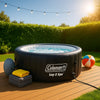
Pros and Cons of Inflatable Hot Tubs — 2025 Guide
, by Alex Morgan, 10 min reading time

, by Alex Morgan, 10 min reading time
The inflatable hot tub market is booming — projected to climb from roughly $1.5 billion in 2024 to about $3.2 billion by 2033, a 9.2% compound annual growth rate. That tells you two things: more families are discovering portable spas, and manufacturers are improving the product fast. If you're weighing the pros and cons of inflatable hot tubs, you're asking a smart question: can a soft-sided, plug-and-play tub deliver meaningful relaxation without saddling your household with hidden costs or safety headaches?
This guide lays out what matters most — durability and lifespan, environmental and water impacts, energy use and heating performance, safety and regulatory issues, and the real economics of ownership. You’ll get specific numbers (how many gallons typical models hold, expected lifespans, energy ranges), practical setup and maintenance tips, and clear buying guidance so you can decide whether an inflatable hot tub is the right fit for your backyard BBQs, apartment balcony, or seasonal staycation plans.
TL;DR
Table of Contents
One of the clearest contrasts in the pros and cons of inflatable hot tubs is longevity. Traditional hard-shell tubs commonly last 15–20+ years thanks to acrylic shells, fiberglass, and metal framing. Inflatable hot tubs typically last 3–5 years under normal use; premium units can reach 5–7 years with careful handling.
Materials matter. Modern inflatable models use multi-layer reinforced PVC, Tritech three-layer fabrics, MaxHold beams, or drop-stitch construction with thousands of interwoven threads. These technologies greatly reduce punctures and seam stress, but they don’t eliminate wear from UV exposure, repeated heating cycles, and chemical attack. Expect seams, valves, and valve connections to be the most vulnerable points.
Maintenance also affects lifespan. A few practical steps extend useful life: place a protective underlayment, keep it shaded when possible to minimize UV damage, avoid dragging it across rough surfaces, and inspect seams and valves monthly. Small repairs (patch kits) can fix punctures, but repeated structural failures usually mean replacement.
Takeaway: If you want portability and lower upfront cost, accept a shorter lifecycle. Buy the best materials and treat the tub gently to approach the upper end of expected lifespans.

Energy is a core practical concern in the pros and cons of inflatable hot tubs. Typical energy use for inflatables is about 3.5–6 kWh per day under normal conditions, with heaters often rated 1,500–2,200 watts. They heat slowly—about 2–3°F per hour—so filling from cold can take 12–24 hours to reach 104°F. Traditional hot tubs use more powerful heaters (often 240V, 6,000 watts) but maintain heat more efficiently thanks to thicker insulation and greater thermal mass.
Insulation advancements for inflatables—like EnergySense-style integrated layers, insulated covers, and pump jackets—can cut heat loss significantly (manufacturers claim up to ~40% improvement vs. basic designs). In cold climates, expect energy consumption to rise sharply; winter operation can increase usage by 50% or more versus temperate conditions.
Operational tip: schedule preheating during off-peak electricity hours if your utility offers lower night rates, use a high-quality insulated cover, and add ground insulation to reduce bottom heat loss.

Takeaway: Inflatable tubs can be affordable to operate in moderate climates with insulation upgrades, but they’re less efficient than well-insulated traditional units—especially in winter.
Safety is a mixed bag in the pros and cons of inflatable hot tubs. They’re easier to set up, but the accessibility and portability introduce specific risks:
Regulatory frameworks vary; many jurisdictions apply the same barrier and electrical requirements to inflatable tubs as to permanent installations. Always follow GFCI requirements and local codes.
Takeaway: With the right electrical setup, consistent water maintenance, and child-safety measures, inflatable tubs can be safe. Skip cutting corners on wiring and supervision.
Initial cost is the headline advantage: inflatables often run $300–$1,500 compared with $8,000–$25,000 for many traditional models. But look at total cost of ownership. Over a 20-year horizon, an $800 inflatable replaced every 4 years totals $3,200–$4,000 in capital alone (plus operating costs). Energy and maintenance add to both sides of the ledger.
Buying tips to tilt the balance toward a pro:
For renters, seasonal users, or families who value portability and lower upfront expense, inflatable hot tubs often win. For those focused on long-term value, deep immersion, or frequent year-round use in cold climates, a permanent unit may ultimately be more economical.
If you're looking for a real-world example of an insulated, feature-rich portable option, consider models like the 4-person inflatable hot tub with EnergySense cover and 120 AirJet system that combines integrated insulation and powerful jets in a portable package.
Takeaway: Match product choice to how you'll use it—seasonal and social use favors inflatables; daily therapeutic use favors traditional tubs.
The pros and cons of inflatable hot tubs come down to trade-offs: lower cost, portability, and easy setup versus shorter lifespan, higher sensitivity to weather and chemicals, and specific safety considerations. They democratize spa ownership for renters, seasonal users, and younger buyers, and technological advances (better materials, insulation, and filtration) are narrowing the gap with traditional tubs. If you prioritize flexibility and lower upfront expense, choose a premium-inflatable model, invest in insulation and filtration upgrades, and get professional electrical help. If long-term durability, deep immersion, and year-round efficiency are top priorities, a traditional hot tub may serve you better.



